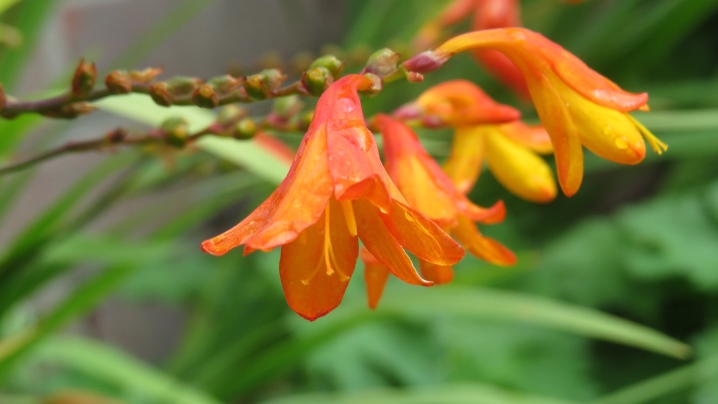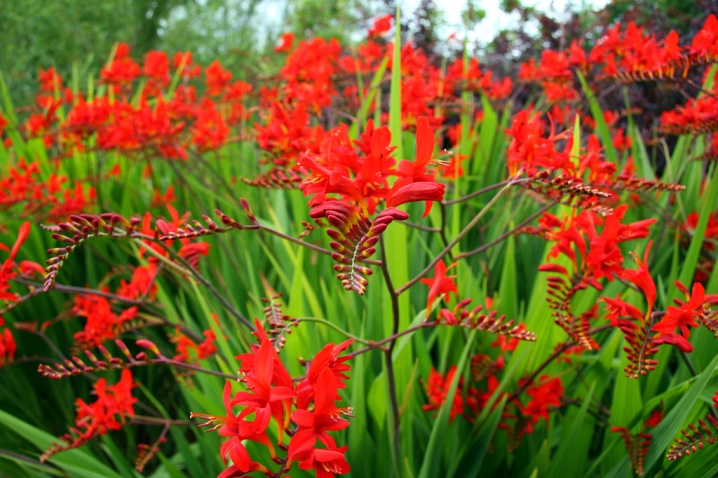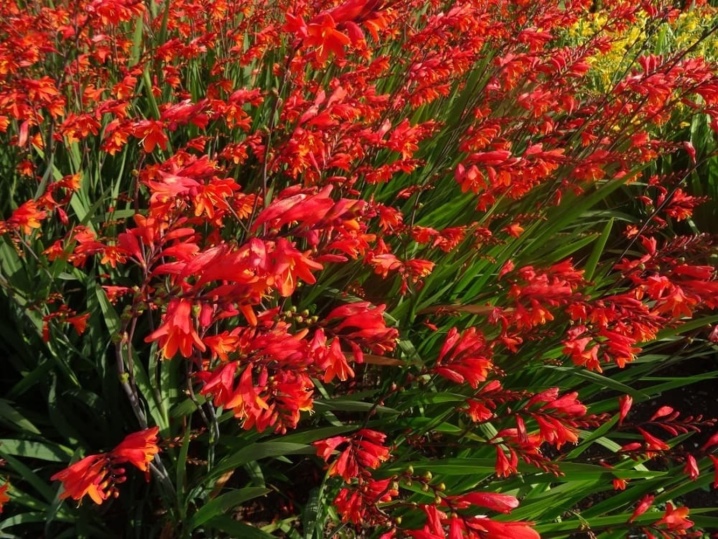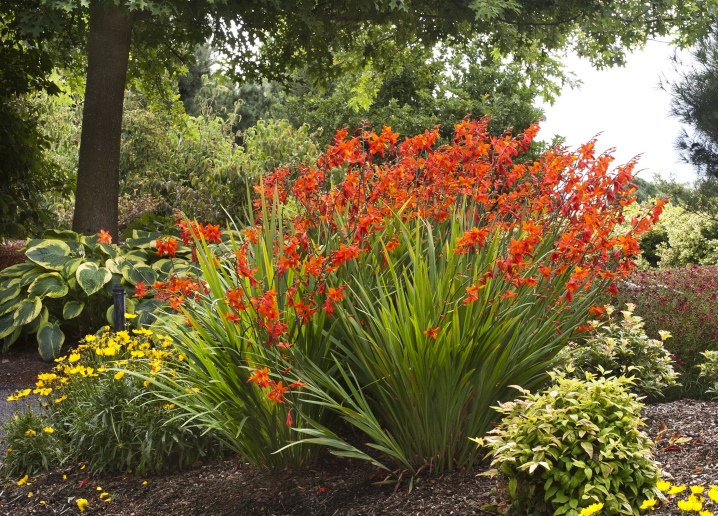Crocosmia: description, types and varieties, planting and care features

Crocosmia, montbrecia, tritonia - this is the name of the same herbaceous perennial shrub that grows naturally in the south of the African continent. The first and most common name is translated from Greek as "the smell of saffron" for the similar scent of a dried flower. The second, now obsolete name, the bulbous perennial was named after the French botanist de Montbre, who brought the flower to Europe. Tritonia in Greek means "weathervane" - perennial got its name for the shape of the inflorescences, giving it a resemblance to gladiolus. Therefore, the plant is also called Japanese or Chinese gladiolus.
Culture is loved by gardeners and florists. Flowers do not fade for two weeks after cutting and are therefore used in bouquets. They do not change color even after drying, which makes them indispensable in the preparation of dried-flower compositions.


Description
Crocosmia is a perennial plant with a thin erect stem, reaching a meter in height, with narrowly obvious or linear light green half-meter leaves of a corrugated structure with a width of 0.5 to 3 cm... A deep groove runs along the leaf. Montbrecia can grow up to 150 cm high. The stem has powerful peduncles with dense spike-shaped or paniculate inflorescences. Peduncles with numerous buds grow in the middle of summer. The buds bloom in turn, releasing a dozen bright flowers.

On one stem of the cultivated variety of Japanese gladioli, there can be up to 10 of them, in contrast to the wild ones, which produce only 5 flowers each. Small flowers (4 cm) with petals from yellow, orange, red and brown shades of tubular or star-like shape resemble a funnel. These bright petals of inflorescences can be compared with fiery tongues, or even with red-winged moths. Montbrecia blooms in early summer and blooms until frost. Faded flowers simply fly off the arrow, the rest continue to bloom, so the perennial always has a decorative look.

After the end of the flowering season, the fruit ripens in the form of a polyspermous rounded box with large brown seeds. The root system is a few overgrown corms with brown shells. The multi-layered 3 cm bulb is slightly flattened. During its growth, the mother bulb grows overgrown with tubers. In the spring, the bulbs sprout, and then a stem that is one and a half meters long is pulled out of it.


European gardening culture has been familiar with crocosmia since the 19th century, and its hybrids appear in the 20th century. Having crossed two types of crocosmia: golden and Potts, the French breeder of ornamental plants Victor Lemoine in the 19th century grew a hybrid culture, which is now called common crocosmia.
Views
More than 50 different species of tritonia and several dozen hybrids are now known in nature, but only a small part of them are cultivated. The most common are these types.
Massonorum
Unpretentious, compact bush with good frost resistance. The 80-centimeter stem has ribbed leaves and inflorescences of small showy yellow, orange and red flowers that bloom in July. The bush is able to grow in wetlands.

Golden
The parent species from which the initial experiments of breeders began. It was he who was brought from the South African tropics, he is the ancestor of all varieties subsequently bred. From summer to September, yellow tubular flowers up to 5 cm in length bloom on a stem up to 80 cm long. In nature, golden crocosmia grows in forests and loves shaded areas.

Potts
In the African range, it grows on marshy soils. That's why plants are selected for places with moist soil. The species has the narrowest foliage and the smallest orange tubular flowers.

Paniculata
A tall one and a half meter variety with corrugated light green foliage. Compact panicle orange blossoms bloom in July. This is the earliest flowering species of all members of the family.

Ordinary
A hybrid created in 1880 by Victor Lemoine when crossing the golden crocosmia and Potts crocosmia. It turned out to be a powerful meter high bush. Leaves are relatively large, up to 50 mm wide with light greens, and consist of erect, narrow and graceful plates. The inflorescence includes small funnel-shaped buds. The first brushes appear by July. The flowers are medium in size, their diameter can be up to 50 mm in yellow, red and orange tones.

Varieties
These adorable herbaceous, bulbous perennials are cultivated by breeders all over the world. Every year, novelties of world selection appear not only with flowers of traditional colors, but now there are pink and white crocosmias. Modern breeders have developed amazing bright and beautiful varieties.
- "Lucifer" - This hybrid variety has one and a half meter stems with unusually spectacular brightly colored red flowers.
The variety is frost-resistant and unpretentious, with qualities inherited from the original type of paniculata.

- Emily McKenzie - late-flowering medium-sized 60-centimeter variety with large, bright and variegated flowers with brownish and orange spots at the base. Prefers to grow in light partial shade.

- Red King... Representatives of the variety really look royal. Their stems are straight, powerful, stretching over a meter.

- George Davidson "George Davidson"... The variety has delicate and showy medium-sized flowers with gracefully open amber-yellow petals, rounded at the ends. The leaves of the representatives of this variety are green, but darker than those of others.

- Carmine Brilliant "Carmine Diamond" - tuberous 60-centimeter perennial with small funnel-shaped flowers of reddish-orange coloration of spike-shaped inflorescences. Blooms from August to September.

- Babylon "Babylon" - a bush over half a meter tall with bright drooping orange or red flowers.

- "Star of the East". The plant is fantastically showy and beautiful, loves a lot of sun and warmth. Its leaves are quite wide, more than 50 mm wide, with flowers about 120 mm in diameter. The star-shaped apricot-orange flowers look like lilies.
It is a large-flowered, late-flowering, but less frost-resistant variety.

Landing rules
The climatic factors of our regions make it possible to plant this exotic beauty in the open ground, observing certain rules. In the middle lane, the montbrecia is planted in the spring in already heated and drained areas. First, you should very carefully choose a place in the garden. It should be well lit by the sun.
Planted in an open, sunny and windless space, the African beauty will be able to show all her splendor. In such garden plots, bulbous perennials bloom better than in partial shade, where the plant will turn violently green, but not bloom.

Tritonia take root better in humus-rich, loose and moist soil. It is important to prepare a place for planting already in the fall by fertilizing the soil, which will provide the necessary nutrition for the subsequently planted bulbs.... Growth conditions will be greatly improved if drainage is arranged in such an area.The future full development of ornamental culture will depend on whether organic fertilizers containing nitrogen are applied to the soil in the spring before planting.


The bulbs are planted in rows. The planting depth depends on the size of the corms, but not less than 7 cm with a distance of 10 cm between them. In order for the plants to develop freely, they should not be planted too often. In addition, if planted tightly, the bulbs will lack nutrients. You should also take note of the following points.
- Before planting, the bulbs must be treated with a solution of potassium permanganate for disinfection. Additionally, it stimulates growth.
- The bulb should not be planted upside down. Otherwise, it will germinate much later and be weakened.
- It is not recommended to plant montbrecia of different varieties on the same bed. This will lead to over-pollination and loss of the original properties of the planting material.
- For an earlier flowering culture, it should be grown in containers and planted in the ground with a lump of earth.

Care features
Proper care will help to grow crocosmia from a bulb with lush and long flowering. Full development will be supported by agrotechnical measures. For this unpretentious decorative perennial, it is moistening and fertilizing, as well as taking preventive measures against diseases and pests.
Watering
It is not recommended to increase the moisture level in the soil. It is necessary to adhere to the correct watering regime - only moderate evening moistening of the earth every 3-4 days. In waterlogged soil, tubers can get sick with a fungus. Moistened soil after watering should be loosened more often, thereby ensuring good air circulation. Then the brown reticulated shells of the corms will not rot. Of course, in the summer heat it is necessary to increase the number of waterings, but abundant watering is prohibited.

Top dressing
Japanese gladioli thrive on fertile soils. It is recommended to lay a sufficient amount of nutrients in poor soil before planting in the ground. And then, as the soil is depleted, it must be periodically fed. In early spring, as soon as the earth dries up slightly, organic fertilizers with nitrogen in the composition need to be applied. And when the plants begin their vegetative period, they will be able to absorb everything they need from bird droppings, manure infusion, humus, introduced ammonium nitrate or urea.
In July, when inflorescences form intensively and corms develop, fertilizers containing potassium... Subsequently, liquid mineral complexes are introduced every 10 days.
After the end of flowering, tritonia need a third additional feeding with a superphosphate solution.


Garter to support
Basically, crocosmia is not tied to a support. A strong foundation for them is created by foliage, thanks to which the long stems keep their shape well. The flower is tied to a support only when the tritonia is tall and growing in an open place.
It is necessary to cut off already faded flowers in time. This will increase the decorativeness of the montbrecia and will enable the corms to be nourished with useful substances for winter.

Preparing for winter
Because of their African origin, most species only hibernate in mild, snowy winters, requiring good drainage and careful shelter. Preparation for winter begins after the end of the flowering of crocosmia. They carry out all the necessary agrotechnical measures. The first necessary procedure is pruning, when all the green part is cut off. This helps build up nutrients in the bulbs.
In the southern regions, the plant does not need to be dug up; it usually hibernates in dry soil with mandatory mulching. Therefore, before the onset of the autumn heavy rains, gardeners must first cover the tubers with dry foliage or sawdust. You can lay a plastic wrap on top. But when the snow melts in the spring, you should hurry to remove the shelters.

A well-sheltered montbrecia can also winter in the middle zone with a temperate climate. For wintering, the plant is dug with a large clod of earth, while the bulbs are not disassembled, but stored together in the basement in cardboard boxes or wooden boxes so that the bulbs do not dry out. And only in the northern regions with a harsh winter, already in mid-September, the tubers need to be dug up and further stored in the basement. For greater preservation of the quality of the planting material, it is necessary to store it until the next season in well-prepared boxes, boxes, containers and pallets with sawdust.
Regardless of the region, once every three years in the fall, preferably no later than October, the tubers are dug up, processed, kept warm, and planted again in the spring. This allows you to preserve the decorative qualities of flowers and prevent rotten or diseased tubers from spreading to others. Early digging of the bulbs is undesirable, otherwise the tubers and children will not have time to absorb nutrients before wintering. For breeding purposes, planting material is also dug up in the fall, corms are processed and divided.

Reproduction methods
Montbrecia is propagated vegetatively (corms) or seeds. Sown directly into open soil, the seeds may not germinate, so seedlings are grown from them first. In early spring, they are placed either simply in water or in a growth stimulator. This will allow you to get seedlings much earlier. Soaked in advance, the seeds sprout all together at once. It is impossible to keep the seeds in water longer than a day, they may deteriorate. The water should be changed regularly during the day.
Then the seeds are sown in a prepared soil mixture, a mixture of hydrogel with agrovermiculite, perlite and sawdust. Most gardeners prefer traditional potting of seeds when growing seedlings. The substrate can also consist of turf, peat, humus and sand. Purchased primer can be used.


Next, the crops are placed in a mini-greenhouse closer to warmth and light. When seedlings appear, remove the cover. The seedlings are watered and the substrate is loosened. The substrate should not be waterlogged in order to avoid fungal diseases. When the third leaf appears, the seedlings are transferred into large containers in order to grow up before transplanting into open ground. Before the procedure for planting on the garden plot, the seedlings should be hardened in the fresh air.
A seedling planted on the site will grow a corm in the summer and bloom in the second or third year after sowing. The easiest way is to divide the bulbs by separating the children from it. Every year from one corm get them up to five pieces. The bulbs and seedlings are planted in the ground at the same time.
It is advisable to plant the corms in advance in containers so that they germinate, and transplant together with an earthen clod.


Pests and diseases
Montbrecia is quite resistant to diseases and pests, however, unfavorable weather conditions and insufficient care for it can contribute to diseases. The most common diseases are fungal.
- Gray rot - when light brown spots are formed on the stem, most often dry. First, the stalk is affected, then a gray spot spreads over the surface of the entire fruit. As a result, the stalk becomes watery and covered with a grayish downy. This is the spore of the fungus.
- Fusarium or dry rot - the leaves begin to turn yellow, first the lower ones from the tips, then the yellowing spreads to the base. On the corm, brown spots appear on the bottom and in the places of attachment of the scales. They are fought with the help of spraying with fungicides.


A viral disease is jaundice or grassiness, from which the tips of the leaves first turn yellow, and then the foliage acquires a straw tint, and the plant dies. This viral disease is carried by leafhoppers. Heat treatment of weakly affected bulbs for half an hour at 45 ° C almost completely destroys the pathogen. But a severe defeat cannot be treated. Affected perennials are dug up and burned.

Of the pests, perennials are threatened by a bear, tobacco thrips, leafhoppers - a slobbering penny and especially spider mites. To destroy them, insecticides are used. Preventive measures against diseases and pests are:
- implementation of agrotechnical measures;
- seed treatment with 1% potassium permanganate solution;
- application in a sufficient amount of fertilizers;
- more rare planting of plants;
- regular cleaning of the area from fallen leaves;
- removing weeds from the site;
- moderate watering;
- loosening the soil cover and the root zone of the culture;
- periodic change of place in the garden.



Use in landscape design
Aesthetic crocosmies are a favorite element of landscape designers in creating a variety of decorative compositions on mixed flower beds - mixborders or rabatkas. Tall varieties of Japanese gladiolus perfectly coexist with shrubs in voluminous flower beds. Low varieties are grown in composite groups. A beautiful variety "Carmine Brilliant" with small funnel-shaped flowers of a fiery color, collected in spike-shaped inflorescences, perfectly decorate group plantings of the foreground in mixborders.



Montbrecia is able to dominate the landscape and perfectly emphasize other plants on the site. You can combine the plant with all ornamental crops grown on the site. The bright beauty of perennial inflorescences in harmony with the flowers of most of both annuals and perennials. Combinations with knifofia, bush chrysanthemums, gailardia, decorative cereals and daylilies look great.



The contrasting shades of neighboring plants will draw attention to every element of the Japanese gladiolus. Amber-yellow grade "George Davidson" harmonizes perfectly with blue and purple crocuses. A snow-white lily will be a harmonious background for the glowing red Lucifer. Varieties with orange, yellow and brown petals will ideally be combined with agapanthus - you get a bright contrast and beautiful composition.
Even the bright and lush greenery of a perennial that grows in the shade and does not bloom will decorate the garden.


You will learn about planting and caring for Crocosmia from the video below.































The comment was sent successfully.